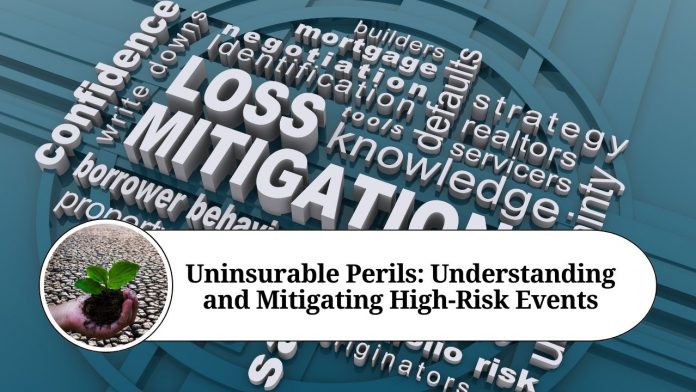Insurance is a valuable tool for mitigating risks and protecting individuals and businesses from financial losses. However, not all risks can be insured against. Some risks are considered “uninsurable perils,” meaning they are too unpredictable, severe, or difficult to quantify for insurance companies to provide coverage.
Uninsurable perils can take many forms, ranging from natural disasters to human-made events. Some common examples include:
- War and terrorism: These events can cause widespread damage and loss of life, making it difficult for insurers to assess and manage the risks associated with them.
- Nuclear incidents: Nuclear accidents or attacks can have catastrophic consequences that are difficult to predict or quantify, making them virtually uninsurable.
- Pandemics: The COVID-19 pandemic has highlighted the challenges of insuring against global health crises, as they can affect entire populations and cause significant economic disruption.
- Acts of God: This term refers to natural disasters such as earthquakes, hurricanes, and floods, which can be devastating but are often difficult to predict or prevent.
- Cyberattacks: As more businesses rely on digital technology, the risk of cyberattacks is increasing. However, insurers struggle to accurately assess the risks and potential losses associated with these events, making them difficult to insure against.
- Environmental pollution: Pollution-related risks, such as oil spills or toxic waste leaks, can have significant environmental and financial consequences. However, insurers may be hesitant to provide coverage due to the high cost of cleanup and potential legal liabilities.
In some cases, insurers may offer coverage for these risks, but at a high cost and with significant limitations. For example, many insurance policies have exclusions for acts of war or nuclear incidents, while others may only cover certain types of natural disasters.
The concept of uninsurable perils underscores the importance of risk management and preparedness. Individuals and businesses should take steps to protect themselves from these risks, such as implementing cybersecurity measures, developing disaster plans, and investing in emergency funds.
Uninsurable perils can have significant consequences for individuals and businesses, particularly those who are not adequately prepared. For example, a small business that suffers a cyberattack may face significant financial losses and reputational damage if they do not have the resources or insurance coverage to manage the fallout. Similarly, individuals who live in areas prone to natural disasters may face financial ruin if they are not prepared for the possibility of a catastrophic event.
As a result, it is essential for individuals and businesses to take steps to manage and mitigate these risks. This may include investing in disaster preparedness plans, such as stockpiling supplies and developing evacuation plans for natural disasters. It may also involve implementing cybersecurity measures to protect against cyberattacks or investing in pollution prevention technologies to reduce the risk of environmental incidents.
Additionally, insurance companies may offer alternative risk management tools for uninsurable perils, such as captive insurance or risk retention groups. These options may provide some coverage for high-risk events but require significant resources and planning to implement effectively.
Conclusion
Overall, the concept of uninsurable perils highlights the importance of comprehensive risk management and preparedness. While insurance can provide a valuable safety net for many risks, it is essential to recognize the limitations of insurance coverage and take steps to manage risks that may be uninsurable. By doing so, individuals and businesses can better protect themselves from the financial and other consequences of unexpected events
Other Related Blogs: Section 144B Income Tax Act
.Frequently Asked Questions (FAQs)
Q: What are uninsurable perils?
A: Uninsurable perils are events or risks that are too unpredictable, severe, or difficult to quantify for insurance companies to provide coverage.
Q: What are some examples of uninsurable perils?
A: Examples of uninsurable perils include war and terrorism, nuclear incidents, pandemics, acts of God (such as earthquakes, hurricanes, and floods), cyberattacks, and environmental pollution.
Q: Can insurance companies offer coverage for uninsurable perils?
A: In some cases, insurance companies may offer coverage for uninsurable perils, but at a high cost and with significant limitations.
Q: How can individuals and businesses protect themselves from uninsurable perils?
A: Individuals and businesses can protect themselves from uninsurable perils by investing in disaster preparedness plans, implementing cybersecurity measures, and taking steps to mitigate environmental risks.
Q: What are some alternative risk management tools for uninsurable perils?
A: Alternative risk management tools for uninsurable perils may include captive insurance or risk retention groups, which provide some coverage for high-risk events but require significant resources and planning to implement effectively.
Q: Why is it important to understand uninsurable perils?
A: Understanding uninsurable perils can help individuals and businesses better manage risks and prepare for unexpected events, even if insurance coverage is not available. This can help to mitigate the financial and other consequences of such events.




















